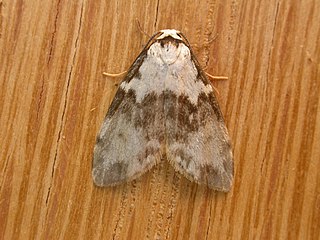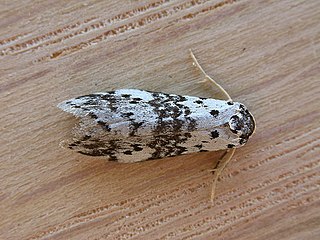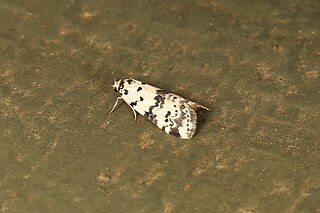
Palaeosia is a monotypic moth genus in the family Erebidae erected by George Hampson in 1900. Its only species, Palaeosia bicosta, the two-ribbed arctiid or two-ribbed footman, was first described by Francis Walker in 1854. It is found in south-eastern Australia.
Phaeophlebosia is a monotypic moth genus in the subfamily Arctiinae erected by George Hampson in 1900. Its single species, Phaeophlebosia furcifera, the forked footman, was first described by Francis Walker in 1854. It is found in Australia, where it has been recorded from New South Wales, Victoria, Tasmania and South Australia.

Termessa nivosa is a moth of the subfamily Arctiinae first described by Francis Walker in 1865. It is found in the Australian states of New South Wales, South Australia and Victoria.

Thallarcha albicollis is a moth of the subfamily Arctiinae first described by Rudolf Felder and Alois Friedrich Rogenhofer in 1875. It is found in Australia, including Tasmania.

Thallarcha epicela is a moth of the subfamily Arctiinae first described by Turner in 1922. It is found in Australia.

Thallarcha partita is a moth of the subfamily Arctiinae first described by Francis Walker in 1869. It is found in the Australian states of New South Wales, Queensland and Victoria.

Thallarcha is a genus of moths in the subfamily Arctiinae.
Castulo plagiata, the yellow-banded footman, is a moth of the subfamily Arctiinae. The species was first described by Francis Walker in 1854. It is found in the Australian states of New South Wales, Victoria and Tasmania.
Thallarcha catasticta, the four-lined footman, is a moth in the subfamily Arctiinae. It was described by Oswald Bertram Lower in 1915. It is found in Australia, where it has been recorded from New South Wales, South Australia, Victoria and Western Australia.
Thallarcha chrysochoa, the golden footman, is a moth in the subfamily Arctiinae. It was described by Edward Meyrick in 1886. It is found in Australia, where it has been recorded from the Australian Capital Territory, New South Wales and Victoria.
Thallarcha epileuca is a moth in the subfamily Arctiinae. It was described by Turner in 1922. It is found in Australia, where it has been recorded from Queensland.
Thallarcha epiostola is a moth in the subfamily Arctiinae. It was described by Turner in 1926. It is found in Australia, where it has been recorded from Tasmania, New South Wales and Victoria.
Thallarcha homoschema is a moth in the subfamily Arctiinae. It was described by Turner in 1940. It is found in Australia, where it has been recorded from Queensland.
Thallarcha isophragma is a moth in the subfamily Arctiinae. It was described by Edward Meyrick in 1886. It is found in Australia, where it has been recorded from Tasmania.
Thallarcha levis is a moth in the subfamily Arctiinae. It was described by Turner in 1943. It is found in Australia, where it has been recorded from the Northern Territory and Queensland.
Thallarcha macilenta is a moth in the subfamily Arctiinae. It was described by Thomas Pennington Lucas in 1894. It is found in Australia, where it has been recorded from New South Wales and Queensland.
Thallarcha mochlina is a moth in the subfamily Arctiinae. It was described by Turner in 1899. It is found in Australia, where it has been recorded from Queensland.
Thallarcha oblita, the hidden footman, is a moth in the subfamily Arctiinae. It was described by Rudolf Felder and Alois Friedrich Rogenhofer in 1875. It is found in Australia, where it has been recorded from the Australian Capital Territory, New South Wales and Victoria.

Thallarcha rhaptophora is a moth in the subfamily Arctiinae. It was described by Oswald Bertram Lower in 1915. It is found in Australia, where it has been recorded from New South Wales, Victoria and Western Australia.







